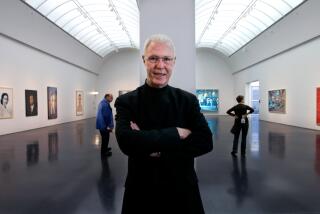Gestures Large and Small at CalArts Festival
- Share via
Sunday night at CalArts, a barefoot, quietly bustling team of performers-workers were busily realizing a piece called “Rain.” In the school’s main gallery space, a layer of white dust was slowly laid in a circle, akin to the sand mandalas made by Tibetan monks. Next, a vast number of white helium balloons were anchored to form a surreal, rubbery cloud formation overhead. All was eerily quiet, except for the occasional “pop!” of an escapee from the balloon population.
For the official performance of the 45-minute piece, part of California Institute of the Arts’ fifth annual festival of experimental computer music, the balloon clouds were made to dance by tugs of the strings, all dramatically illuminated. Gentle, randomly rhythmic, rain-like bleeps constituted the audio portion of the program.
What did this Dadaistic, hands-on piece--devised by Jacob & Carol (Jacob Joaquin and Carole Kim)--have to do with a three-day festival sponsored by the Center for Experimentation in Art, Information and Technology? As it turned out, its unique, process-oriented design embodied much of what took place at the festival, which, in the end, was mostly about a stubborn diversity of voices and ideas.
The experimental-computer music world may still be a relatively marginal and hidden dimension, but it’s full of vigor. And that increases the importance of a local venue like this festival. The event, organized this year by CalArts faculty member Clay Chaplin, has been a work-in-progress itself. It began as a student-sponsored event five years ago; participants from around the world were involved in this year’s event, with programs Friday through Sunday, and a loose after-party Saturday.
Contrasts ruled. After the loopy softness of “Rain,” Bob Bellerue’s “Threat Level Charlie” upped the angst as three musicians bowed pieces of plate glass, producing an aura of volatile intensity, while also illustrating the medium-specific emotional quality of sounds.
Sounds and instruments were being radically tweaked and analyzed all weekend. One of the best, and most darkly impressionistic, laptop-based pieces was Michael Gendreau’s “T921 pt. 2,” an abstract work made of found sounds from Taiwanese and Malaysian factories. Gendreau gradually amassed sounds, suddenly cutting them off to reveal just a low thumping, like an erratic heartbeat, to end the piece.
Anthony De Ritis’ “Plum Blossoms” took as its source recordings by pipa player Min Xiao-Fen, then scattered and reconstituted them into an ultra-exotic construct. For composer Tae Hong Park’s “T1,” trumpeter Edward Carroll was on hand to supply simple gestures and effects, while the composer processed his real-time labors into an electro-acoustic swirl.
In her keynote performance Saturday, San Francisco-based Pamela Z waved her “wired” arms to trigger sounds, created delay loops with her voice (instant background singers) and a range of vocal tones and percussion sounds, all while interacting with a video system that allowed her to appear in triplicate.
In Z’s case, the centrality of her own over-the-top presentation is hard to get around, and contrasts sharply with the almost ascetic performance attitude of others in the experimental world.
Perching at a mixing board, Joe Colley built a dense wall of sound, in and out of which textures flowed. Although his add-and-subtract process was simple, it was effective, and theatrical in its own way.
You could even say that Barry Schrader’s pointed, teasingly brief tape piece grew out of a laconic sense of theater, telegraphed through a fragment of its title: “... an apprehension of something sensed, not expected an impression of something experienced, not remembered ... “ Suffice it to say, contemporary experimental music is going after ideas not easily contained in the usual hooks, structures, isms or sound bites.
More to Read
The biggest entertainment stories
Get our big stories about Hollywood, film, television, music, arts, culture and more right in your inbox as soon as they publish.
You may occasionally receive promotional content from the Los Angeles Times.









